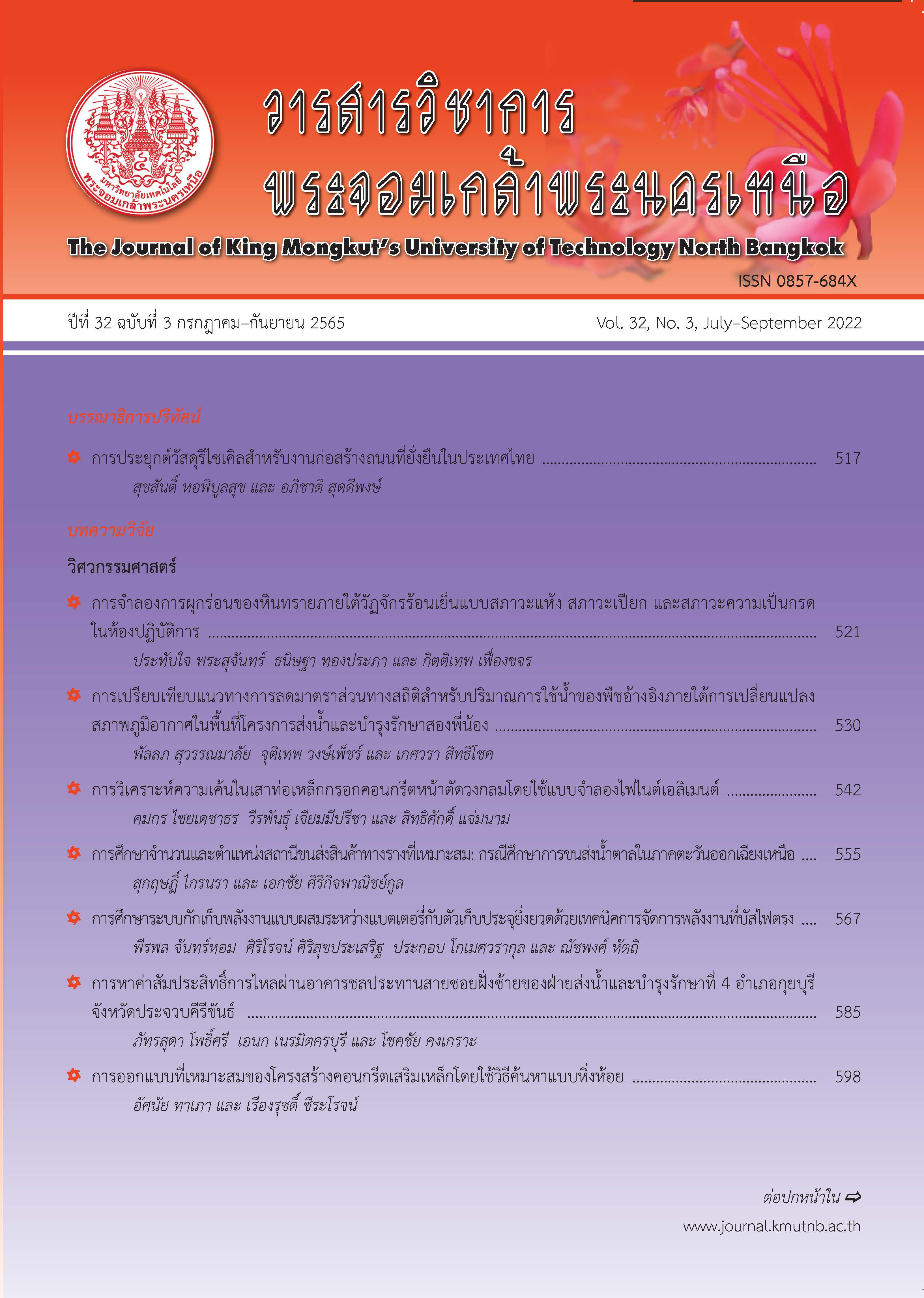สมบัติของวัสดุแซนวิชจากวัสดุเชิงประกอบพลาสติกและผงไม้ยางพาราที่มีแกนกลางจากพลาสติกต่างชนิด
Main Article Content
บทคัดย่อ
ปัจจุบันมีการนำพลาสติกมาใช้งานอย่างแพร่หลายในชีวิตประจำวัน ทำให้เกิดขยะในปริมาณมากและไม่สามารถย่อยสลายด้วยตัวเองได้ ก่อให้เกิดอันตรายต่อชีวิตจากการกำจัดขยะพลาสติกที่ไม่ถูกวิธี ดังนั้นหากมีการนำพลาสติกชนิดต่าง ๆ ที่สามารถนำมาใช้ซ้ำได้จะช่วยลดปัญหาและเพิ่มมูลค่าของพลาสติกใช้แล้วไม่ว่าจะเป็น พอลีเอทีลีนรีไซเคิล พอลีเอทีลีนชนิดความหนาแน่นสูง และพอลีโพรพิลีนรีไซเคิล ซึ่งเป็นชนิดของพลาสติกที่พบว่าเป็นขยะมูลฝอยที่มีปริมาณมาก เพื่อนำมาเป็นแกนกลางในการประกอบเป็นวัสดุแซนวิชจึงเป็นทางเลือกที่น่าสนใจ วัสดุแซนวิชประกอบด้วยแผ่นประกบ 2 ชั้น ทำมาจากวัสดุเชิงประกอบพลาสติกชนิดพอลีโพรพิลีนรีไซเคิลและผงไม้ยางพารา โดยมีวัตถุประสงค์เพื่อปรับปรุงสมบัติทางกลและทางกายภาพของวัสดุเชิงประกอบพลาสติกและไม้ ได้แก่ สมบัติแรงดัด สมบัติการกระแทก ความสามารถในการยึดเหนี่ยวของตะปูเกลียวบริเวณผิวและขอบของชิ้นงานและสมบัติการดูดซับน้ำ แล้วนำมาเปรียบเทียบกับวัสดุเชิงประกอบพลาสติกพอลีโพรพิลีนรีไซเคิลและผงไม้ยางพาราแบบชั้นเดียว โดยมีวิธีการศึกษา 3 ขั้นตอนสำคัญได้แก่ 1) การผลิตแผ่นประกบจากวัสดุเชิงประกอบพลาสติกและไม้ 2) การผลิตแผ่นแกนกลางและ 3) การประกอบเป็นแผ่นวัสดุแซนวิช โดยการนำแผ่นประกบจากวัสดุเชิงประกอบพลาสติกและไม้จำนวน 2 ชิ้นประกบแผ่นแกนกลางแล้วอัดขึ้นรูปด้วยเครื่องอัดร้อนที่อุณหภูมิอยู่ในช่วง 150-190 C ผลการทดสอบพบว่าแผ่นวัสดุแซนวิชมีความสามารถในการรับแรงดัดและแรงกระแทกได้ดีขึ้นถึง 63% และ 68% ตามลำดับ เมื่อเทียบกับวัสดุเชิงประกอบพลาสติกและไม้แบบชั้นเดียว และให้ค่าดีที่สุดเมื่อแผ่นวัสดุแซนวิชมีแกนกลางทำมาจากพอลีโพรพิลีนรีไซเคิลเมื่อเปรียบเทียบกับแกนกลางชนิดอื่นที่ใช้ในการศึกษา นอกจากนี้ยังพบว่าแผ่นวัสดุแซนวิชมีการดูดซับน้ำลดลงมากถึง 67% และให้ค่าความยึดเหนี่ยวตะปูเกลียวทั้งผิวหน้าและขอบชิ้นงานสอดคล้องตามมาตรฐานการทดสอบอีกด้วย
Article Details

อนุญาตภายใต้เงื่อนไข Creative Commons Attribution-NonCommercial-NoDerivatives 4.0 International License.
บทความที่ลงตีพิมพ์เป็นข้อคิดเห็นของผู้เขียนเท่านั้น
ผู้เขียนจะต้องเป็นผู้รับผิดชอบต่อผลทางกฎหมายใดๆ ที่อาจเกิดขึ้นจากบทความนั้น
เอกสารอ้างอิง
H. Fu, M. Dun, H. Wang, W. Wang, R. Ou, Y. Wang, T. Liu, and Q. Wang, “Creep response of wood flour-high-density polyethylene/laminated veneer lumber coextruded composites,” Construction and Building Materials, vol. 237, 2020.
S. M. Mirmehdi, F. Zeinaly, and F. Dabbagh, “Date palm wood flour as filler of linear lowdensity polyethylene,” Composites: Part B, vol. 56, pp. 137–141, 2014.
J. Zhang, Y. Li, D. Xing, Q. Wang, H. Wang, and A. Koubaa, “Reinforcement of continuous fibers for extruded wood-flour/HDPE composites: Effects of fiber type and amount,” Construction and Building Materials, vol. 228, 2019.
A. Zolfaghari and A. H. Behravesh, “Continuous glass fiber reinforced wood plastic composite in extrusion process: Mechanical properties,” Materials & Design, vol. 51, pp. 701–708, 2013.
R. Ou, H. Zhao, S. Sui, Y. Song, and Q. Wang, “Reinforcing effects of Kevlar fiber on the mechanical properties of wood-flour/high-densitypolyethylene composites,”Composites Part A: Applied Science and Manufacturing, vol. 41, no. 9, pp. 1272–1278, 2010.
R. Nasirzadeh and A. R. Sabet, “Study of foam density variations in composite sandwich panels under high velocity impact loading,” International Journal of Impact Engineering, vol. 63, pp. 129–139, 2014.
J. P. Vitale, G. Francucci, J. Xiong, and A. Stocchi, “Failure mode maps of natural and synthetic fiber reinforced composite sandwich panels,” Composites Part A: Applied Science and Manufacturing, vol. 94, pp. 217–225, 2017.
X. Hao, H. Zhou, Y. Xie, H. Mu, and Q. Wang, “Sandwich-structured wood flour/HDPE composite panels: Reinforcement using a linear low-density polyethylene core layer,” Construction and Building Materials, vol. 164, pp. 489–496, 2018.
Y. Zhang, Z. Zong, Q. Liu, J. Ma, Y. Wu, and Qing Li, “Static and dynamic crushing responses of CFRP sandwich panels filled with different reinforced materials,” Materials & Design, vol. 117, pp. 396–408, 2017.
G. -I. Shim, H. -W. Eom, S. -H. Kim, J. -K. Park, and S. -Y. Choi, “Fabrication of lightweight and thin bulletproof windows using borosilicate glass strengthened by ion exchange,” Composites Part B: Engineering, vol. 69, pp. 44–49, 2015.
G. -I. Shim, S. -H. Kim, D. -L. Ahn, J. -K. Park, D. -H. Jin, D. -T. Chung, and S. -Y. Choi, “Experimental and numerical evaluation of transparent bulletproof material for enhanced impact-energy absorption using strengthenedglass/ polymer composite,” Composites Part B: Engineering, vol. 97, pp. 150–161, 2016.
G. -I. Shim, S. -H. Kim, H. -W. Eom, D. -L. Ahn, J. -K. Park, and S. -Y. Choi, “Improvement in ballistic impact resistance of a transparent bulletproof material laminated with strengthened soda-lime silicate glass,” Composites Part B: Engineering, vol. 77, pp. 169–178, 2015.
Pollution Control Department. (2020, August 9). Plastic Waste Management 2018 [Online] (in Thai). Available: http://www.pcd.go.th/info_serv/waste.html
C. Homkhiew, T. Ratanawilai, and W. Thongruang, “The optimal formulation of recycled polypropylene/rubberwood flour composites from experiments with mixture design,” Composites: Part B, vol. 56, pp. 350–357, 2014.
Department of Primary Industries and Mines. (2020, August 10). Waste account database [Online] (in Thai). Available: http://recycle.dpim.go.th
M. A. M. Elamin, S. X. Li, Z. A. Osman, and T. A. Otitoju, “Preparation and characterization of wood-plastic composite by utilizing a hybrid compatibilizer system,” Industrial Crops & Products, vol. 154, 2020.
L. Jiang, J. Fu, and C. He, “Reliability analysis of wood-plastic composites in simulated seawater conditions: Effect of iron oxide pigments,” Journal of Building Engineering, vol. 31, 2020.
X. Gao, L. Lin, J. Pang, F. Chen, and Q. Li, “Effects of impulse-cyclone drying and silane modification on the properties of wood fiber/HDPE composite material,” Carbohydrate Polymers, vol. 207, pp. 343–351, 2019.
X. Hao, X. Yi, L. Sun, D. Tu, Q. Wang, and R. Ou, “Mechanical properties, creep resistance, and dimensional stability of core/shell structured wood flour/polyethylene composites with highly filled core layer,” Construction and Building Materials, vol. 226, pp. 879–887, 2019.
S. Y. Shen, F. J. Masters, H. L. Upjohn II, and C. C. Ferraro, “Mechanical resistance properties of FRP/polyol-isocyanate foam sandwich panels,” Composites Structures, vol. 99, pp. 419–432, 2013.
D. G-. García, A. Carbonell, M. D. Samper, D. G.-Sanoguera, and R. Balart, “Green composites based on polypropylene matrix and hydrophobized spend coffee ground (SCG) powder,” Composites Part B: Engineering, vol. 78, pp. 256–265, 2015.
Y. Zhua and Y. Sun, “Dynamic response of foam core sandwich panel with composite facesheets during low-velocity impact and penetration,” International Journal of Impact Engineering, vol. 139, 2020.
K. B. Adhikary, S. Pang, and M. P. Staige, “Long-term moisture absorption and thickness swelling behaviour of recycled thermoplastics reinforced with Pinus radiata sawdust,” Chemical Engineering Journal, vol. 142, no. 2, pp. 190–198, 2008.
R. Ou, Y. Xie, M. P. Wolcott, S. Sui, and Q. Wang, “Morphology, mechanical properties, and dimensional stability of wood particle/high density polyethylene composites: Effect of removal of wood cell wall composition,” Materials & Design, vol. 58, pp. 339–345, 2014.

